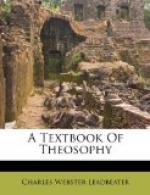The personality wears three bodies or vehicles, the mental, the astral and the physical. While the man is what we call alive and awake on the physical earth he is limited by his physical body, for he uses the astral and mental bodies only as bridges to connect himself with his lowest vehicle. One of the limitations of the physical body is that it quickly becomes fatigued and needs periodical rest. Each night the man leaves it to sleep, and withdraws into his astral vehicle, which does not become fatigued, and therefore needs no sleep. During this sleep of the physical body the man is free to move about in the astral world; but the extent to which he does this depends upon his development. The primitive savage usually does not move more than a few miles away from his sleeping physical form—often not as much as that; and he has only the vaguest consciousness.
The educated man is generally able to travel in his astral vehicle wherever he will, and has much more consciousness in the astral world, though he has not often the faculty of bringing into his waking life any memory of what he has seen and done while his physical body was asleep. Sometimes he does remember some incident which he has seen, some experience which he has had, and then he calls it a vivid dream. More often his recollections are hopelessly entangled with vague memories of waking life, and with impressions made from without upon the etheric part of his brain. Thus we arrive at the confused and often absurd dreams of ordinary life. The developed man becomes as fully conscious and active in the astral world as in the physical, and brings through into the latter full remembrance of what he has been doing in the former—that is, he has a continuous life without any loss of consciousness throughout the whole twenty-four hours, and thus throughout the whole of his physical life, and even through death itself.
Chapter VI
AFTER DEATH
Death is the laying aside of the physical body; but it makes no more difference to the ego than does the laying aside of an overcoat to the physical man. Having put off his physical body, the ego continues to live in his astral body until the force has become exhausted which has been generated by such emotions and passions as he has allowed himself to feel during earth-life. When that has happened, the second death takes place; the astral body also falls away from him, and he finds himself living in the mental body and in the lower mental world. In that condition he remains until the thought-forces generated during his physical and astral lives have worn themselves out; then he drops the third vehicle in its turn and remains once more an ego in his own world, inhabiting his causal body.




